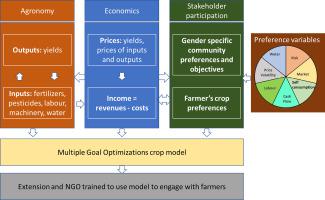Agricultural Systems ( IF 6.6 ) Pub Date : 2021-10-18 , DOI: 10.1016/j.agsy.2021.103300 Uday Nidumolu 1 , Marcel Lubbers 2 , Argyris Kanellopoulos 3 , Martin K. van Ittersum 2 , Christian H. Roth 4 , Pulak Mishra 5 , Niladri Sekhar Bagchi 5 , Subrata Majumdar 6 , Lucy Carter 7 , Md. Wakilur Rahman 8 , Mahanambrota Das 9 , Donald S. Gaydon 10

|
CONTEXT
In northern West Bengal and southern Bangladesh, Rabi crops, sown in winter and harvested in the spring, are an important source of income and nutrition for the target communities. In the study areas, NGOs and extension services have been engaging with farming communities on selecting suitable crops for the upcoming season. This engagement took place in the absence of quantitative tools to discuss trade offs and what-if scenarios to support an informed discussion.
OBJECTIVE
The objective of this study was to design a crop-choice model to support extension agronomists in engaging with the farming communities more effectively using a quantitative analysis tool. In this process, we explored how agricultural system models can be inclusive and allow participation and eventual application by NGO and government extension agents, using a process of gender sensitive contribution.
Methods
The crop-choice model includes several constraints related to available resources, including land, labour, capital and technologies to calculate optimal crop areas within the Rabi season. The crop choices are determined considering gender specific community perceptions of risks, labour use, market, price-volatility, self-consumption, water use and cash flow. The model was used to explore the consequences of different crop choices on income, gender specific labour, use of inputs and markets, and to reveal the trade-offs of pursuing different crop choice pathways in the context of agricultural intensification. The initial model was demonstrated to the farmers and the extension agents, and based on their reflections, it was fine-tuned further to make the engagement process more effective. For better communication with the participating farmers, the model related questions and findings were translated in the local language (Bengali).
RESULTS AND CONCLUSIONS
We found that the modelling process can be made more inclusive from the outset by including farmers, NGO and extension agents as co-contributors of the model at each of the modelling steps and incorporating their reflections. Such an inclusive and reflective approach provides easy-to-use interfaces and enables translation of model results in ways that more effectively benefit farming communities. The process of engagement with farmers during tool development has been very valuable to farmers and researchers alike and the use of the tool has made the farmers informed about alternative scenarios and led to actual benefits for crop choice decision making. Inclusive farming systems models need to consider the gender dimension and its critical role in farm decision making and how this can be included in models to reflect the diversity of decision process. To maximise relevance of the model for next users and farmers, it was important that these key stakeholders were part of the model development from the beginning, this study has focused on the same throughout.
SIGNIFICANCE
This study demonstrated that appropriate design and development principles enabled bioeconomic farming systems models to be used by NGO and government extension agents to engage with farming communities as discussion support tools in farming decisions. Such an approach would make the engagement process more convincing and effective. Besides, it would also provide useful insights to the NGO and extension agents in revising their intervention strategies.
中文翻译:

在作物选择的讨论支持工具中整合性别和农民的偏好
语境
在西孟加拉邦北部和孟加拉国南部,冬季播种、春季收获的拉比作物是目标社区的重要收入和营养来源。在研究区域,非政府组织和推广服务机构一直在与农业社区合作,为即将到来的季节选择合适的作物。这种参与是在缺乏量化工具来讨论权衡和假设情景以支持知情讨论的情况下进行的。
客观的
本研究的目的是设计一个作物选择模型,以支持推广农艺师使用定量分析工具更有效地与农业社区互动。在这个过程中,我们探索了农业系统模型如何能够具有包容性,并允许非政府组织和政府推广机构参与并最终应用,使用性别敏感贡献的过程。
方法
作物选择模型包括几个与可用资源相关的限制,包括土地、劳动力、资本和技术,以计算 Rabi 季节内的最佳作物面积。作物选择是根据特定性别的社区对风险、劳动力使用、市场、价格波动、自我消费、用水和现金流的看法来确定的。该模型用于探索不同作物选择对收入、性别特定劳动力、投入物使用和市场的影响,并揭示在农业集约化背景下追求不同作物选择途径的权衡。最初的模型向农民和推广人员展示,并根据他们的反映进行了进一步微调,以使参与过程更加有效。为了更好地与参与农户沟通,
结果和结论
我们发现,通过在每个建模步骤中将农民、非政府组织和推广代理作为模型的共同贡献者并纳入他们的思考,可以从一开始就使建模过程更具包容性。这种包容和反思的方法提供了易于使用的界面,并能够以更有效地造福农业社区的方式翻译模型结果。该过程在工具开发过程中与农民接触对农民和研究人员都非常有价值,使用该工具使农民了解替代方案,并为作物选择决策带来实际利益。包容性农业系统模型需要考虑性别维度及其在农业决策中的关键作用,以及如何将其纳入模型以反映决策过程的多样性。为了最大限度地提高模型对下一个用户和农民的相关性,重要的是这些关键利益相关者从一开始就是模型开发的一部分,本研究始终关注相同的内容。
意义
这项研究表明,适当的设计和开发原则使非政府组织和政府推广机构能够使用生物经济农业系统模型与农业社区互动,作为农业决策中的讨论支持工具。这种方法将使参与过程更具说服力和有效性。此外,它还将为非政府组织和推广机构修改其干预策略提供有用的见解。


























 京公网安备 11010802027423号
京公网安备 11010802027423号